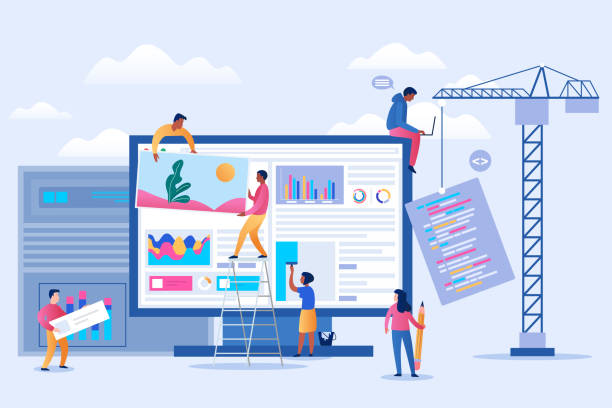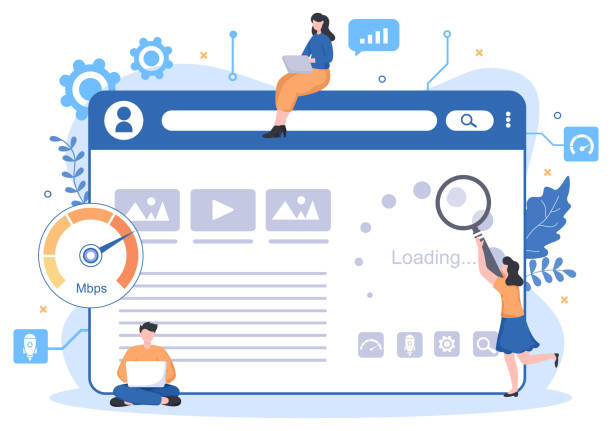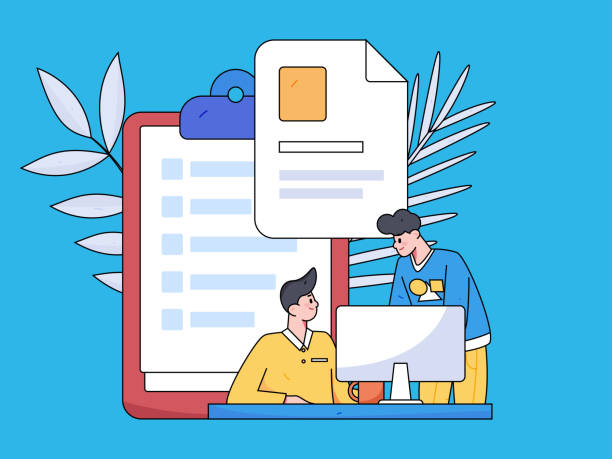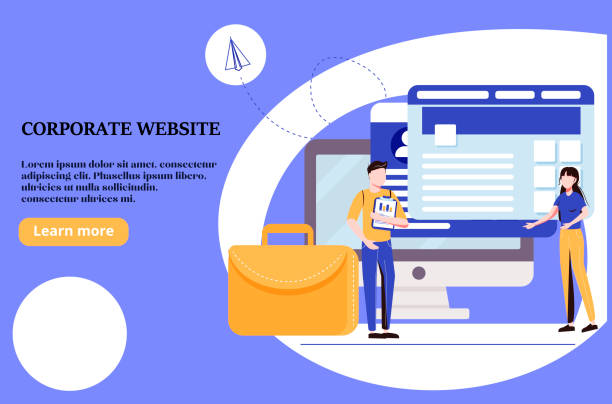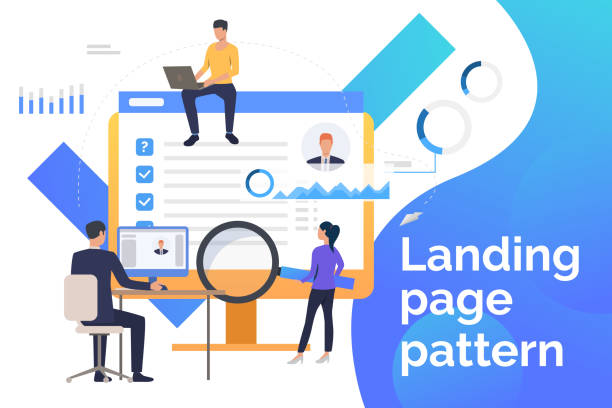Why is Website Speed Critically Important in the Current Era?
In the current digital age, where users seek instant information and unparalleled user experiences, website speed is no longer a competitive advantage, but an undeniable necessity.
Fast website design not only directly impacts your SEO and search engine rankings, but also serves as a determining factor in retaining users and increasing conversion rates.
Imagine entering a website that takes more than a few seconds to load; you would probably leave it without hesitation.
This is exactly the problem businesses face with slow websites.
Poor user experience (UX) due to low speed directly leads to a high bounce rate, which is a negative signal for search engines like Google.
Furthermore, potential customers may be lost before even viewing your products or services.
Therefore, investing in fast website design is, in fact, an investment in the success and sustainability of your online business.
This not only meets user expectations but also significantly increases your return on investment (ROI).
This is a #specialized topic that requires deep understanding and can be posed as a #thought-provoking content: Can you afford the risk of losing your customers due to low site speed? The answer is definitely no.
This is a guide to start speed optimization.
Did you know that your company’s website is the first point of contact for 75% of potential customers?
Your website is the face of your brand. With **Rasaweb**’s corporate website design services, build an online presence that earns customer trust.
✅ Create a professional and lasting image for your brand
✅ Attract target customers and boost online credibility
⚡ Get a free consultation from **Rasaweb** experts!
Key Factors Affecting Website Loading Speed
Understanding what factors influence website speed is the first step towards fast website design.
These factors can be divided into two main categories: server-side factors and front-end (user-side) factors.
Among the most important server-side factors are the quality and type of hosting, the geographical location of the server, and its configuration.
An unoptimized server or shared hosting with limited resources can significantly increase the Time To First Byte (TTFB).
On the front-end side, the size of images and videos, the number and size of CSS and JavaScript files, the use of web fonts, and the lack of proper caching are among the main reasons for reduced loading speed.
For example, high-resolution and uncompressed images can astronomically increase page size.
Inefficient coding and extra plugins can also significantly slow down the site.
Content Delivery Networks (CDNs) also play an important role in loading speed, as they deliver content from the server closest to the user.
This educational and specialized section helps you identify the root causes of your website’s slowness and take effective steps towards web speed optimization.
A precise understanding of these factors sets the stage for implementing fast website design strategies and provides a comprehensive view of the challenges and solutions.
Front-End Optimization Techniques for Fast Website Design
Front-end optimization involves a set of actions aimed at reducing the size and number of HTTP requests from the user’s browser to the server.
The first and most important step in fast website design is image optimization.
Using modern image formats like WebP instead of JPEG or PNG, and compressing images without significant quality loss, can dramatically reduce page sizes.
Additionally, implementing Lazy Loading for images and videos that are not initially visible on the screen greatly contributes to user experience.
This technique ensures content is only loaded when the user scrolls to that section of the page.
Next is Minification of CSS and JavaScript files; this process involves removing extra characters, whitespace, comments, and new lines from the code, which reduces file sizes without altering functionality.
Concatenation of CSS and JavaScript files can also reduce the number of HTTP requests, although its importance has lessened with the advent of HTTP/2 and HTTP/3.
Using Browser Caching allows the browser to store static resources like images, CSS, and JS for subsequent visits, preventing their re-loading.
This is a very important educational and guidance section that plays a key role in accelerating website loading.
These actions, collectively, help significantly improve loading speed and provide a smoother user experience.
To better understand the differences in image formats, see the table below:
| Image Format | Advantages | Disadvantages | Impact on Speed |
|---|---|---|---|
| JPEG | Suitable for photos, good compression | Quality decreases with high compression | Medium, depends on compression level |
| PNG | Transparency (alpha channel), suitable for graphics | File size usually high | Slow, especially for large images |
| WebP | Smaller size with similar quality to JPEG/PNG | Limited support in older browsers | Very fast, recommended |
Click here to preview your posts with PRO themes ››
The Role of Server and Back-End in Increasing Site Speed
In addition to front-end optimization, fast website design is heavily dependent on server and back-end performance.
The beating heart of any website is its server, and its quality and configuration directly impact the Time To First Byte (TTFB).
Choosing appropriate hosting, which we will discuss in detail in a separate section, is one of the most important initial decisions.
Quality and optimized servers, especially Virtual Private Servers (VPS) or cloud hosting, can provide more resources for your website and prevent resource congestion.
Furthermore, using server-side caching, such as Redis or Memcached for data and Page Caching for full pages, can significantly reduce server processing load and improve response time.
Content Delivery Networks (CDN) also play a crucial role in loading speed by storing copies of static website content on multiple servers worldwide, delivering content from the closest point to the user, which reduces physical distance and significantly boosts loading speed.
Moreover, database optimization, such as proper indexing, cleaning old data, and using efficient queries, plays a vital role in increasing website speed.
Optimized back-end coding, using efficient frameworks, and keeping server software up-to-date (like PHP, Apache/Nginx) are other specialized and explanatory points that help achieve a high-speed website.
This is a key section for anyone looking for fast website design.
Are you tired of your e-commerce website not generating as much revenue as it could? Rasaweb, specializing in professional e-commerce website design, solves this problem once and for all!
✅ Increase sales rate and revenue
✅ High loading speed and unparalleled user experience
⚡ Get a free consultation for e-commerce website design
Powerful Website Speed Evaluation Tools
After implementing optimization techniques, the next step is to evaluate and measure their impact.
For fast website design, using appropriate tools to measure website speed is essential.
These tools not only help you assess your site’s current speed but also identify strengths and weaknesses and provide recommendations for improvement.
Google PageSpeed Insights is one of the most popular and important tools provided by Google, offering a score for your website’s speed on both desktop and mobile.
This tool, based on Google’s Core Web Vitals, provides specific suggestions for performance improvement.
Another tool, GTmetrix, displays more comprehensive information including full loading time, page size, number of requests, and a Waterfall Chart, which helps you visualize the resource loading order and identify bottlenecks.
Pingdom Tools is another tool that provides similar results and allows you to test site speed from various geographical locations.
Using these tools is an educational and guidance section that helps you continuously monitor and improve your site’s performance.
Regularly reviewing these reports and acting upon their recommendations greatly assists you in maintaining and enhancing website speed, ensuring that your efforts to build a fast website have paid off.
This continuous monitoring and optimization is an integral part of a fast and optimized website design strategy.
Impact of Fast Website Design on SEO and Google Ranking
Website speed has long been an important factor in SEO and website ranking by search engines, but its importance has doubled with the introduction of Core Web Vitals by Google.
Core Web Vitals are a set of user experience metrics that evaluate the loading performance, interactivity, and visual stability of a web page.
These metrics include Largest Contentful Paint (LCP) for loading speed, First Input Delay (FID) for interactivity, and Cumulative Layout Shift (CLS) for visual stability.
Websites that perform well on these metrics receive positive scores from Google and have a higher chance of ranking better in search results.
Fast website design directly impacts these metrics; the faster your website, the higher your chances of meeting Google’s standards.
In addition to Core Web Vitals, site speed also affects Bounce Rate and Dwell Time, both of which are important signals for Google’s ranking algorithms.
Slower websites lead to a poor user experience, which in turn results in users quickly leaving the site and a decrease in search rankings.
This is an analytical and explanatory analysis that shows why every business should invest in optimizing their website speed.
Understanding these connections is crucial for SEO success and increasing online visibility.
User Experience and Higher Conversion Rates with High-Speed Websites
Beyond SEO, website speed directly impacts user experience (UX) and, ultimately, conversion rate.
In today’s world, users expect websites to load instantly.
Any delay, even a fraction of a second, can lead to users leaving the site and lost business opportunities.
A fast website design provides a smooth and enjoyable user experience.
Users can access content, fill out forms, browse products, and make purchases without long waits.
This ease of use not only increases user satisfaction but also boosts their trust in your brand.
Countless studies have shown that even a one-second increase in page load time can lead to a significant decrease in conversion rates.
For example, for an e-commerce website, this means losing thousands of dollars in potential revenue.
A slow website can create a negative image of your business, leading customers to believe you do not care about details and quality.
This aspect of fast website design is an engaging yet analytical topic, as it examines the psychological impact of speed on consumer behavior.
Investing in increasing website speed is, in fact, an investment in improving customer relationships, increasing loyalty, and sustainable business growth.
The table below shows the impact of loading time on bounce rate and conversion:
Click here to preview your posts with PRO themes ››
| Page Load Time (seconds) | Impact on Bounce Rate | Impact on Conversion Rate |
|---|---|---|
| 1 | Lowest | Highest |
| 3 | 32% Increase | 8% Decrease |
| 5 | 90% Increase | 15% Decrease |
| 10 | 123% Increase | 20%+ Decrease |
These figures highlight the critical importance of building a high-speed website.
Choosing Suitable Hosting: A Prerequisite for Any Fast Website Design
The foundations of any fast website design are built upon a strong and optimized hosting.
The type of hosting you choose significantly impacts your website’s loading speed and overall performance.
There are various types of hosting, including Shared Hosting, Virtual Private Server (VPS), Dedicated Server, and Cloud Hosting.
Shared hosting is usually the cheapest option, but its resources are shared among multiple websites, which can lead to slower speeds during peak traffic.
For fast website design with medium to high traffic, VPS or cloud hosting are better options as they provide more dedicated resources.
Dedicated servers offer the highest level of performance and control but are more expensive and require more technical knowledge to manage.
When choosing hosting, consider the following factors: server geographical location (proximity to your target audience), bandwidth and hardware resources (RAM, CPU), use of SSD instead of HDD, support for new PHP and HTTP/2 versions, and the availability of server-level caching features.
Additionally, checking the hosting company’s uptime reliability and technical support is very important.
Quality hosting can minimize server response time (TTFB) and provide the necessary infrastructure for your high-speed website.
This vital guidance and specialized section is often overlooked, but its role in accelerating website loading is undeniable.
Choosing the right hosting is the first step towards ensuring a fast and efficient website design.
Does your current corporate website present a worthy image of your brand and attract new customers?
If not, turn this challenge into an opportunity with Rasaweb’s professional corporate website design services.
✅ Significantly improves your brand’s credibility and image.
✅ Paves the way for attracting new leads and customers.
⚡ For a free and specialized consultation, contact Rasaweb now!
Common Mistakes in Website Speed Optimization and How to Avoid Them
On the path to fast website design, many developers and website owners make common mistakes that can nullify their optimization efforts.
One such mistake is neglecting image optimization.
Large, uncompressed images can severely increase page size and lead to very slow loading, even if other aspects are optimized.
The solution is to always optimize images before uploading and use modern formats like WebP.
Another common mistake is excessive use of plugins and add-ons.
While plugins can quickly add new functionalities to a site, too many or low-quality plugins can create extra code and unnecessary HTTP requests, significantly reducing speed.
The solution is to use only essential and reputable plugins and regularly review and update them.
Lack of mobile optimization is also a major error.
Given that most web traffic comes from mobile devices, a website that is fast on desktop but slow on mobile will quickly lose its users.
Responsive design and attention to mobile Core Web Vitals are crucial.
Also, ignoring caching at various levels (browser, server, CDN) can dramatically reduce speed.
Proper implementation of caching strategies can reduce server load and accelerate loading time.
This is an educational and explanatory section that helps you avoid these pitfalls and achieve a truly high-speed website.
By understanding these mistakes and ways to prevent them, you can proceed with your fast website design process more efficiently and effectively.
Click here to preview your posts with PRO themes ››
The Future of Fast Website Design: AI and New Technologies
The world of fast website design is constantly evolving, and new technologies are rapidly emerging that can elevate user experience and loading speed to unprecedented levels.
One of the most important trends is the role of Artificial Intelligence (AI) in website optimization.
AI algorithms can automatically compress images, minify code, and even determine the best caching strategies based on user behavior and real-time traffic.
This automation makes the web speed optimization process much simpler and more efficient.
Another growing technology is HTTP/3, which is built upon the QUIC protocol.
This newer protocol, compared to HTTP/2, significantly increases loading speed, especially in noisy and mobile networks, by reducing latency and improving connection management.
Serverless Architectures are also gaining popularity.
In this model, developers do not need to manage servers, and code is executed only when needed, leading to higher scalability and efficiency, and consequently, faster website design.
Advancements in front-end frameworks, such as Next.js and Nuxt.js, which support capabilities like Server-Side Rendering (SSR) and Static Site Generation (SSG), also contribute to creating much faster websites.
These news and analytical trends indicate that the future of fast website design relies on the use of artificial intelligence, advanced communication protocols, and scalable architectures.
By being aware of these technologies, you can prepare yourself to build the next generation of high-speed websites.
Frequently Asked Questions
| Question | Answer |
|---|---|
| What is the concept of fast website design? | It refers to the process of building a website whose pages load quickly and in the shortest possible time for users. |
| Why is site speed important? | Site speed is crucial for better user experience, reducing visitor bounce rates, increasing page views, and improving search engine rankings (SEO). |
| What factors affect website loading speed? | Image and file sizes, unoptimized coding, server speed and location, lack of caching and CDN usage, and a high number of HTTP requests. |
| What is the role of images in site speed? | Large images can severely reduce site speed. They should be compressed, optimized, and used in appropriate formats. |
| Is server (hosting) speed important? | Yes, server response time directly impacts the initial loading time of the site. Choosing suitable hosting is very important. |
| How does site coding affect speed? | Clean, optimized, minified, and error-free coding reduces file sizes and increases processing speed. |
| How does using Caching help? | Caching allows the user’s browser to store some site information, so on subsequent visits, not everything needs to be reloaded, and the site displays faster. |
| Do extra plugins and scripts slow down the site? | Yes, excessive or improper use of plugins, widgets, and extra scripts can cause the site to slow down. |
| How can site speed be tested? | By using reputable online tools such as Google PageSpeed Insights, GTmetrix, or Pingdom Tools. |
| What are the key tips for fast website design? | Image optimization, using CDN, enabling caching, reducing HTTP requests, optimizing CSS and JavaScript, and choosing quality hosting. |
And other services of Rasaweb Advertising Agency in the field of advertising
Smart Sales Automation: An innovative platform for improving campaign management with marketing automation.
Smart Brand Identity: An effective tool for analyzing customer behavior using intelligent data analysis.
Smart Digital Advertising: A fast and efficient solution for campaign management focusing on marketing automation.
Smart Marketplace: A fast and efficient solution for digital branding focusing on optimizing key pages.
Smart Advertorials: A dedicated service for digital brand growth based on Google Ads management.
And over hundreds of other services in the field of internet advertising, advertising consultation, and organizational solutions
Internet Advertising | Advertising Strategy | Advertorial
Sources
Importance of Site Speed in SEOKey Tips for Increasing Site SpeedImpact of Site Speed on User ExperienceWhy is Fast Website Design Essential?
? Is your business ready to leap forward in the digital world? Rasaweb Afarin Digital Marketing Agency, by providing comprehensive and innovative solutions, paves the way for your success. From professional website design and SEO optimization to managing targeted advertising campaigns, we are with you at every stage of your business growth.
📍 Tehran, Mirdamad Street, next to Bank Markazi, Southern Kazeroon Alley, Ramin Alley, No. 6


